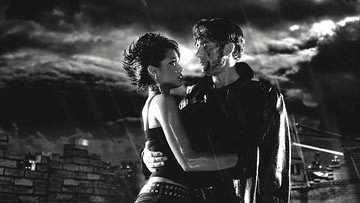

The name Frank Miller means little to most people, but after Sin City, this will not be an issue. Miller has somewhat of an iconic status in the world of comics. He had legendary runs on Daredevil and Batman, and later Sin City. His work seems to be flooding into theaters at the moment, as his stories served as the basis for Elektra, Batman Begins, and of course, Sin City, a series of noir-inspired graphic novels from Dark Horse. Miller had some bad experiences with Hollywood (Robocop 2), so director Robert Rodriguez had to convince him that he would do a good job of adapting the novels to the big screen. The results are quite possibly the best adaptations from the world of comics to the movies in history (this is both good and bad). Rodriguez's commitment to quality was so great that he resigned from the Director's Guild of America when they would not let him share a co-directing credit with Miller (too bad for the DGA).
The look of Sin City is the best thing about it. It looks like Rodriguez literally took the images inside the comics and moved them to the big screen. Everything is in varying shades of black and white, with small, arresting shots of color. An actor's eyes, a red dress, golden hair, and of course, deep red blood punctuate the screen every time a splash of color appears. This is the world of film noir, of Spillane and Hammett vividly brought to life. Everything was filmed using green screen technology, so aside from the guns, costumes, and cars, nearly everything is fake. This allows Rodriguez (Once Upon a Time in Mexico, Spy Kids 3D) Miller, and guest director Quentin Tarantino (Kill Bill Vol.1, Kill Bill Vol. 2) to create a world closer to that of Miller's than anything in real life. There is no screenplay credit, but the film is based on three of Miller's novels, The Big Fat Kill, The Hard Goodbye, and That Yellow Bastard. In an unusual step, Rodriguez used the graphic novels as a storyboard and script, so the resulting film is unusually close to its source product.
The world of Sin City is populated by hookers, crooks, and corrupt cops. There are very few 'good' guys, and the ones that are have plenty of skeletons in their closet. The men all smoke and wear trench coats, and the women wear little to nothing at all. Corrupt policeman have an uneasy truce with the prostitutes, and corrupt politicians keep their equally corrupt children out of jail. In one story, Dwight (Clive Owen, Closer, King Arthur) is trying to prevent a street war from breaking out. Jackie Boy (Benicio Del Toro, 21 Grams, The Hunted) is harassing hookers, and Gail (Rosario Dawson, Alexander, The Rundown), the leader of all of the prostitutes, will have no part of it. In a second story, the hulking, disfigured Marv (Mickey Rourke, Man on Fire, Once Upon a Time in Mexico) hunts for the killer of Goldie (Jamie King, White Chicks, Bulletproof Monk), a beautiful hooker who was also the only person who ever said something nice to him. He is framed for her murder, and goes on his own rampage trying to find the real killer. In the last story, Hartigan (Bruce Willis, Hostage, The Whole Ten Yards) saves a young girl from a pedophile (Nick Stahl, Terminator 3, Twist), only to find himself framed for the crime. Years later, he seeks out this girl, Nancy Callahan (Jessica Alba, Honey, Paranoid), now a nineteen year old stripper. The cast is impressive, and also includes smaller performances by Elijah Wood, Carla Gugino, Michael Clarke Duncan, Devon Aoki, Josh Hartnett, and Alexis Bledel. The men (the non-sadistic ones) are trying to find some sort of redemption, and Rourke and Willis' performances stand out.
The only place that Rodriguez and Miller fall short of their lofty aspirations is in the dialogue. There is a fundamental difference in how people enjoy comics and the movies. Comics are a visual medium, so a certain amount of reading is normal. Miller and Rodriguez took the dialogue boxes and translated them as internal voiceovers. This means that a significant amount of the dialogue is voiceover, typically consistent of tough, punchy language. It has the unintended effect of sucking life out of the story. Movies rely on both sounds and images, and while Sin City excels in the latter, the former is lacking. Sin City is also a violent movie. There are multiple dismemberments, castrations, and deaths in all sorts of gruesome manners. Rodriguez and Miller are able to obscure some of this using black and white silhouettes, again mimicking the graphic novels. This is definitely a great looking movie. It could have been a better sounding one.